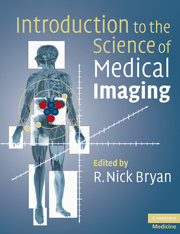7 - Magnetic resonance imaging
Published online by Cambridge University Press: 01 March 2011
Summary
Sixty years after the first demonstration of nuclear magnetic resonance in condensed phase, and over three decades after the first cross-sectional image was published, magnetic resonance imaging (MRI) has without doubt evolved into the richest and most versatile biomedical imaging technique today. Initially a mainly anatomical and morphological imaging tool, MRI has, during the past decade, evolved into a functional and physiological imaging modality with a wide spectrum of applications covering virtually all organ systems. Today, MRI is a mainstay of diagnostic imaging, playing a critically important role for patient management and treatment response monitoring. Even though the physics of MRI is well understood, getting a grasp of the method can be challenging to the uninitiated. This brief chapter seeks to introduce the MRI novice to the fundamentals of spin excitation and detection, detection sensitivity, spatial encoding and image reconstruction, and resolution, and to provide an understanding of the basic contrast mechanisms. For an in-depth treatment of theory, physics, and engineering aspects, the reader is referred to the many excellent texts. Applications to specific organ systems are covered in other chapters of this book.
Magnetic resonance signal
Unlike transmission techniques such as computed tomography (CT), where the attenuation of a beam of radiation is measured and an image reconstructed from multiple angular projections, the nuclear magnetic resonance (NMR) phenomenon exploits the magnetic properties of atomic nuclei, typically protons.
Information
- Type
- Chapter
- Information
- Introduction to the Science of Medical Imaging , pp. 160 - 171Publisher: Cambridge University PressPrint publication year: 2009
